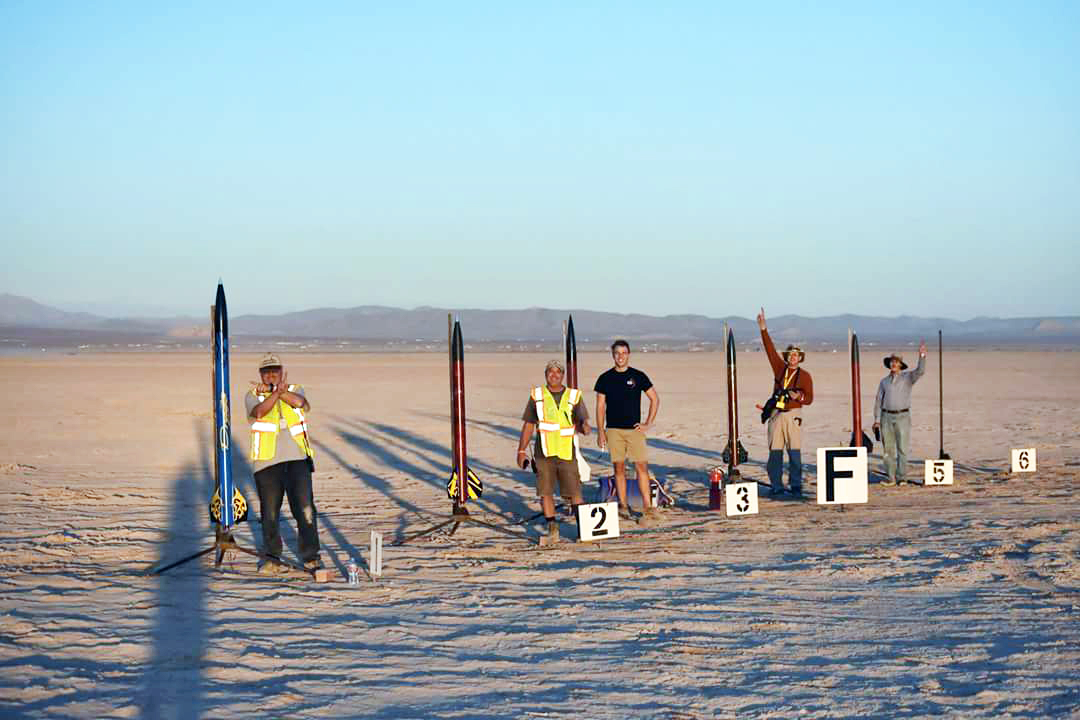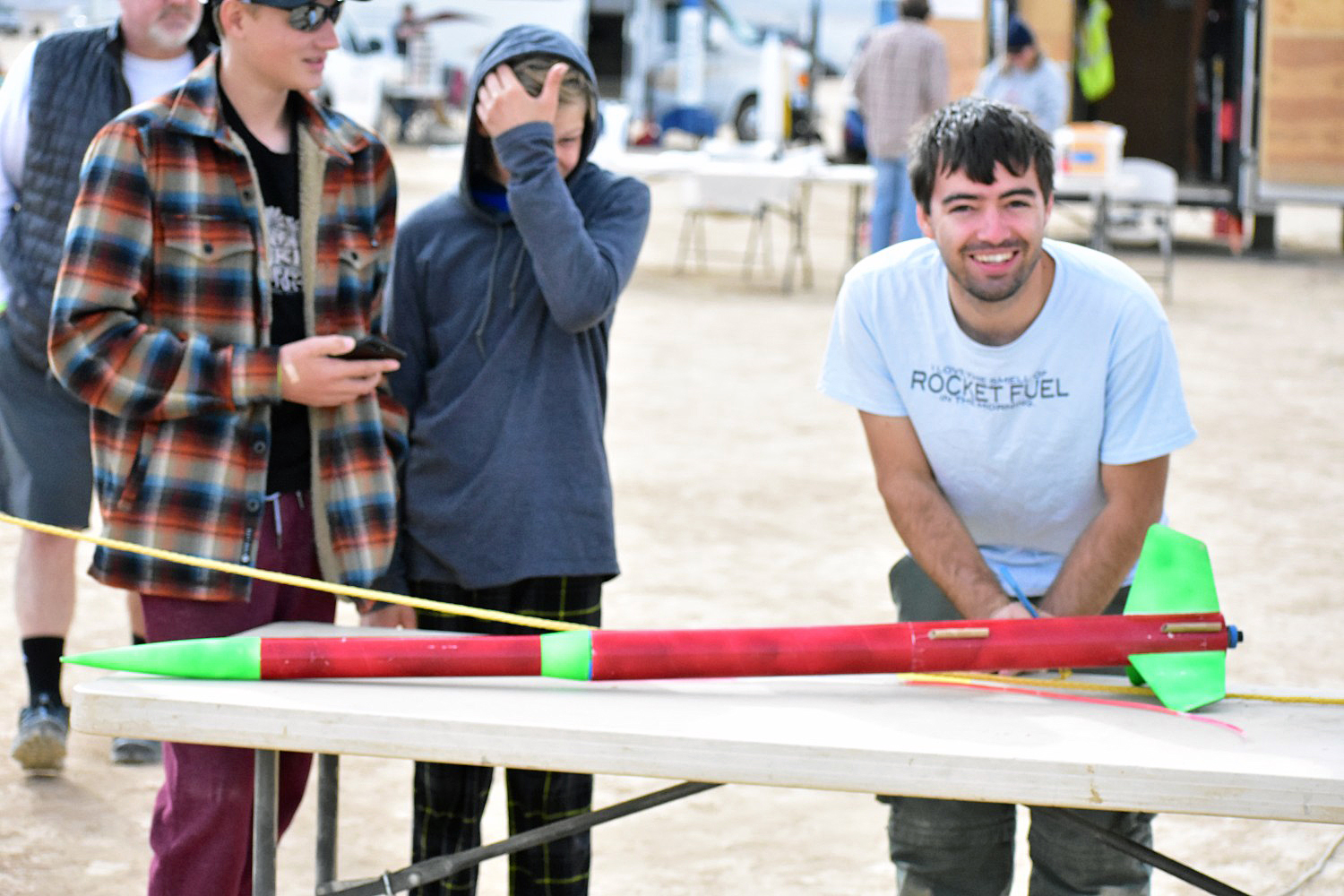Everyone is welcome to come out and watch us fly (and it is totally free!) However, rocketry is an inherently dangerous activity – objects often fall from the sky, sometimes at a very high speed. We have rules and procedures to make this activity as safe for everyone as possible, but bad things can happen. Everyone attending must understand and follow these rules to ensure safety:
- Before you come to NSL , please read the information on the Launch Site page about the weather and conditions we expect.
- Check in at Registration as soon as you arrive and sign the ROC Agreement and Liability Release Form to indicate understanding and acceptance of the risk and liability involved in being at a rocket launch. [Having the form filled out in advance will speed things up a bit.]
- Pay attention! Every flight is potentially dangerous to you and your family. If the Launch Control Officer (LCO) yells “Heads up!” he means it!
- Parents please keep your children under control and be sure they understand these rules.
- Please stay behind the flagged flight line barrier, and please do not set up your chairs, etc. at the barrier or in the safety zone.
- Spectators are not allowed on the range at any time.
- If the LCO announces a flight as a “Heads Up” flight, that means get on your feet and pay attention until the rocket’s recovery device deploys, or until the rocket is on/in the ground.
- If you are away from the pad area and cannot hear the public address speakers, please tune your FM radio to 90.1 MHz to monitor LCO announcements.
- Do not attempt to catch any rocket as it lands. Even a small rocket can cause an injury.
- Do not pick-up or move any rocket that is not yours, unless you have the owner’s permission.
- Do not drive wheeled vehicles along the flight line. This includes ATVs, bicycles, tricycles, etc.
- Park your car behind the line marked on the lakebed, and please do not park in any areas designated for vendors or for launch administration.
- RVs and motor homes must park in the second row.
- Please drive 5MPH or less as you approach the launch area, and within the launch area. A vehicle moving any faster can raise a surprising amount of very annoying dust!
- ROC does not allow anyone to fly R/C aircraft, including “drones” or toys, over or within 1500 feet of the parking area, spectators, safety zones, or structures (including portapotties). R/C aircraft in these areas will result in the range being closed until the situation is corrected and the risk abated. This is regardless of size or registration of the aircraft. We do allow drones or helicopters on the range for special purposes like getting a cool video of a launch, see below for requirements.
- Drones or helicopters on the range require permission from the Launch Director (or designee), the LCO, and RSO at the range head. Drones or helicopters may only fly over the range during launching–not when the range is open for loading or recovery. No R/C aircraft may fly over or near any person, vehicle, launch pad, or other structure, and must be clear of any rocket during all phases of flight.
- Please use only the provided toilet facilities (portapotties). Please do not throw trash into the portapotties!!
- Please keep control of your trash and carry it off the lakebed when you leave.

Flying at NSL 2019
- Please plan to attend the flyers’ meeting and safety brief at 7:45 a.m. each morning.
- Launches usually start at about 8 a.m. and continue until we run out of motors, the weather stops us, or 4 p.m..
We are planning night launching Friday and Saturday nights of NSL 2019, weather permitting.
On Sunday, which is the last day of NSL, launching will probably wrap up by about 1 p.m.. - ROC has all of the pads and equipment necessary to put on a large launch, so please don’t bring your own pad unless you need something special. Vendors will be on site to sell rocket kits, supplies, and motors.
- You, as a flyer, probably know that rocketry is an inherently dangerous activity – objects often fall from the sky, sometimes at a very high speed. We have rules and procedures to make this activity safe for everyone as possible, but bad things can happen if the rules are not followed.
Each flyer is responsible for following applicable safety codes and ensuring their rocket is safe to fly! - Everyone flying must understand and follow these rules to ensure safety:
Check in at Registration as soon as you arrive and sign the Agreement and Liability Release Form to indicate understanding and acceptance of the risk and liability. Flyers will be given a credential to indicate that they have registered. Credentials may not be transferred to another person, even temporarily. - Pay attention! Every flight is potentially dangerous to you and your family. If the Launch Control Officer (LCO) yells “Heads up!” it means look up!
- Please keep your children, friends, and family under control and be sure they understand these rules.
- Please fill out the correct flight card for your flight before arriving at the RSO table. The card must be legible! We have four card styles: a red card for heads up (complex, multi-stage, cluster, etc.), and certification flights, a white card for night flights, a green card for low power (up to D), and a yellow card for all other flights.
- During NSL 2019 we expect to conduct night launches. All night launch rockets must have a light that is visible throughout the flight – meaning from before liftoff all the way to touchdown. A light only deployed at apogee is not acceptable. Additional lights, LEDs, electroluminescent strips, etc. are recommended.
- All motors of impulse class “F” and above must have their ignitors installed at the pad. If you arrive at the RSO with an ignitor installed you will be asked to immediately leave the line to correct the problem, and you will have to wait in line again. Note there are only two exceptions to this rule:
- The ignitor must be built-in to the motor during construction; in this case, all ignitor leads must remain shorted together until the rocket is on the pad.
- The rocket is a cluster rocket; in this case, ignitors may be loaded in a designated area within the range.
- All rockets must be inspected and approved by the Range Safety Officer (RSO) or a Flight Safety Reviewer (FSR) prior to each flight. Please be prepared to show that your rocket is powered by a motor approved by the Office of the California State Fire Marshall, that it will have a stable flight, and that it will recover safely.
- Flight Safety Reviewer (FSR) volunteers (the folks in brightly colored vests) can inspect and approve your rocket, to help shorten the RSO line at the range head, and may come to your rocket, rather than you having to bring your rocket to the RSO. This is especially helpful with large projects. If you have a project that should be inspected before you bring it to the range head, ask for a Roving FSR at the registration area.
- Rockets with total impulse of class “M” (5120 NS) or greater must have documentation for the RSO showing that the rocket will be stable.
- All electronic recovery devices must be made safe, shunted, or powered off when the rocket is brought to the RSO/FSR.
- Radio Control (RC) systems used on the range connected to any pyrotechnic devices (ignitors or backup charges) must be commercially available systems that are specifically designed for remote ignition of pyrotechnic devices (such as, but not limited to, the Missile Works WRC or Digifire systems). No car/aircraft/boat systems may be used for ignition or backup charges. Note: This restriction does not apply to control system of RC boost gliders, only their ignition and ejection charges.
- The Pad Manager will assign your pad after the rocket is approved by the RSO/FSR. If you have any difficulty with your pad, please ask the PM for assistance.
- Do not enter the range to load or recover a rocket until the Launch Control Officer (LCO) announces “the range is open“. Anyone entering the range when it is not open will require all launching to stop.
- You may pick up or move another flyer’s rocket that has landed only under the following conditions:
- You have the owner’s permission to do so.
- If you are a long distance away, and the rocket is undamaged, and no one appears to be looking for it, you may carefully bring it back to the LCO table; if the rocket is damaged, please note the location and report it to the LCO.
- If a rocket is being dragged by the wind, please carefully stop the rocket and place the parachute under its body tube or nose cone, and note the location and report it to the LCO.
- If you find a reloadable motor casing that has been ejected from a rocket, wait until it has cooled off and bring it back to the LCO table.
- For communication with the LCO from the Away pads, or when otherwise needed, ROC has business band radios that can be borrowed by flyers to ensure good communication.
 Important FAA Waiver Information
Important FAA Waiver Information
The FAA does control the airspace above our launch site. We have been granted a waiver to fly up to 14,500′ AGL (feet above ground level) for NSL 2019. We can also offer call-in waivers to 19,000 AGL for this event.
California Motor Restrictions
We operate in strict compliance with all regulations of the California Office of the State Fire Marshal (OSFM). Therefore, you may only fly motors legal in California, up to your certification level. Currently, that means no single motor larger than an “M” (10,240 NS), and a maximum total installed impulse equivalent to an “N” motor (20,480 NS). Also, all motors used must be classified as “Model Rocket Motors” or “High Power Rocket Motors” by the Office of the State Fire Marshal. The motor, or associated packaging/paperwork, must show a CA OSFM stamp, or the flyer must provide documentation to demonstrate that it is legal to fly in California. Our on-site vendors only sell motors that have been classified by the CA OSFM.
Fire Restrictions
The launch site and surrounding area have been placed under Stage II fire restrictions, probably throughout the Summer. For Stage II restrictions no open fires are allowed. Fires must be in containers elevated off the lakebed and should be fully screened. A permit is required for any fire. A California Campfire Permit is required, even for camp stoves, lanterns, and similar devices with a shut-off valve.
The permit is free, but you must ensure it is issued and you have a hard copy in hand before lighting any such device. Smoking is limited to an area where there is no vegetation within five feet, so basically the entire Lucerne Dry Lake.
